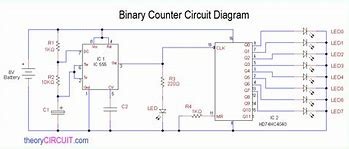what is the BCD counter?
what is the BCD counter? The word BCD stands for binary coded decimal, a class of binary encodings in which encoding of decimal numbers occurs. And the digits are represented by a fixed number of bits normally 4 or 8.
The BCD is a serial digital counter that counts ten digits and it resets for every new clock input it is also known as decade counter.it is designed by a group of flip-flops. with an applied clock signal it is most widely used digital counter.it has 16 potentials and 4 flip flop.

What are the uses of BCD counter?
In modern-day BCD is still used with real-time clocks or RTC chips to keep track of wall-clock time and it’s becoming more common for embedded microprocessors to include an RTC. It’s very common for RTCs to store the time in BCD format.
Applications of BCD counter
The electronic circuit with a clock signal is known as a decade counter. It is a 4-bit binary input and output circuit. The applications of BCD counter or decade counter are as follows
- Clock circuits
- Frequency dividers
- Frequency counting circuits
- State machines
- Sequencers
- Clock division
- CMOS low power circuits
- Integrated oscillators
- Clock generation
- Used as inputs compatible with TTL etc
Drawback:
The drawback of this system is that it creates the counting delay, and the propagation delay also occurs during the counting stage
BCD and Engineering:
It is used for accurate representation of decimal number and it’s conversion to and fro.
what is the difference between up and down counter?
Synchronous counter is in which the clock input is across all the flip-flops use the same source and it creates the same clock signal at the same time. So a counter which is using the same clock signal from the same source at the same time is called Synchronous counter. They easily built there is time delay in their operation. A 4-bit Synchronous up counter start to count from 0 (0000 in binary) and increment or count upwards to 15 (1111 in binary) and then start new counting cycle by getting reset. Its operating frequency is much higher than the same range Asynchronous counter. Also, there is no propagation delay in the synchronous counter just because all flip-flops or counter stage is in parallel clock source and the clock triggers all counters at the same time.
Advantages:
- It’s easier to design than the Asynchronous counter.
- It acts simultaneously.
- No propagation delay associated with it.
- Count sequence is controlled using logic gates, error chances are lower.
- Faster operation than the Asynchronous counter.
Disadvantage of working with Synchronous counter is that it requires a lot of extra logic to perform.
Use of Synchronous Counter
Few applications where Synchronous counters are used-
- Machine Motion control
- Motor RPM counter
- Rotary Shaft Encoders
- Digital clock or pulse generators.
- Digital Watch and Alarm systems.
Asynchronous:
It stands for the absence of synchronization. Something that is not existing or occurring at the same time. In computing or telecommunication stream, Asynchronous stands for controlling the operation timing by sending a pulse only when the previous operation is completed rather than sending it in regular intervals.
Advantages and Disadvantages of Asynchronous Counter
Asynchronous counters can be easily built using Type D flip-flops. They can be implemented using “divide by n” counter circuit, which offers much more flexibility on larger counting range related applications, and the truncated counter can produce any modulus number count.
But, despite those features, Asynchronous counter offer some limitations and disadvantages.
While using the Asynchronous counter, an additional re-synchronizing output flip-flops required for resynchronizing the flipflops. Also, For the truncated sequence count, when it is not equal to , extra feedback logic is needed.
When counting a large number of bit, due to the chain system, propagation delay by successive stages became too large which is very difficult to get rid of. In such a situation, Synchronous counters are faster and reliable. There are also counting errors in Asynchronous Counter when high clock frequencies are applied across it.
| UP counter | DOWN counter |
| All flip-flops are given the same clock simultaneously.
It is known as a parallel counter
· There is no connection between the output of a flip-flop and the clock input of the next flip-flop.
· The settling time is equal to the time it takes for the last flip-flop to get activated. This is quite less compared to the asynchronous counters.
· Synchronous counters are faster
· This design gets more complicated as the number of flip-flops increases. |
· The flip-flops are not given the same clock
· It is known as a serial counter
· The output of a flip-flop is given as the clock input to the next flip-flop
· The settling time or the time taken for all the flip-flops to get activated is equal to the sum of all the times needed to activate the last flip-flop
· Asynchronous counters are slower
· The design of asynchronous counters is easy |
Also read here
https://eevibes.com/digital-logic-design/draw-the-state-diagram-of-sequential-logic-circuits/